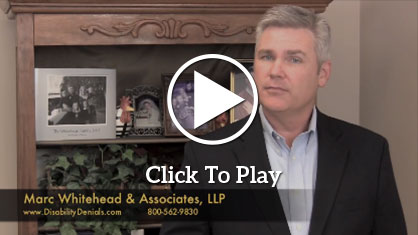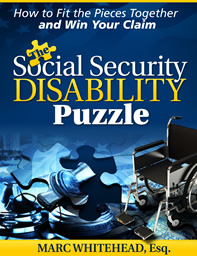How to Fit the Pieces Together and Win Your Claim
The majority of Social Security Disability claims are initially denied. In fact, less than one-third of all claimants who are not represented by attorneys succeed in winning their claims. With attorney representation, the number of successful claims doubles.
The truth is, in many cases the claimant has a very legitimate and justifiable claim. What can you do on your own as a disabled individual to help your case? What information is needed to present your case fully?
This eBook cuts through the red tape and breaks down the Social Security Disability claim process into clear and understandable steps.
To download the eBook, just click on the eBook cover or Title link below. A new window will open that contains the PDF file. Be sure to save it to your computer [click File and Save As]
The Social Security Disability Puzzle
How to Fit the Pieces Together and Win Your Claim
You will need Adobe Acrobat Reader™ in order to open and read the above book.
Click here to download Adobe Reader (a new window will open).
Get answers – in plain English – to the questions and issues that obstruct and confuse so many who try to qualify for Social Security Disability benefits, yet fail. This book provides the roadmap to a successful outcome in a disability case.
Written by attorney Marc Whitehead, Board Certified in Social Security Disability Law by the National Board of Social Security Disability Advocacy – this book is filled with facts based on years of experience and a commitment to the rights of the disabled.
Get the facts about what the SSA decision makers need to have in order to approve your claim:
- Understand the 5-Step Evaluation the SSA uses to determine disability
- Know what Residual Functional Capacity (RFC) is and how it applies to you.
- Learn how to determine the difference between Sedentary Work, Light Work, Medium Work, Heavy Work, and Very Heavy Work
- Understand how the SSA determines disability according to Vocational Standards
- Know what the “non-disability” requirements are to qualify for Social Security Disability
- Get the inside story about the Social Security appeals process and how it works
- We clearly explain the Supplemental Security Income program, and how it is different from Social Security Income
- Understand when you should consider getting a disability attorney
- Find out how attorney fees work – and how they are regulated by the Social Security Administration
Please note, the above book is provided for educational purposes only. The information in the book is not intended as legal advice. A licensed attorney should be consulted directly on all legal issues that may affect you or your case. Call Marc Whitehead & Associates today for a free consultation at 800-562-9830.








